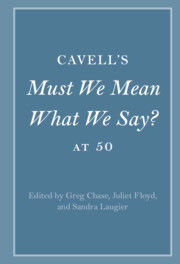Book contents
- Cavell’s Must We Mean What We Say? at 50
- Cambridge Philosophical Anniversaries
- Cavell’s Must We Mean What We Say? at 50
- Copyright page
- Contents
- Contributors
- Acknowledgments
- Abbreviations for Cavell’s Works
- Introduction
- Part I Ordinary Language and Its Philosophy
- Part II Aesthetics and the Modern
- 5 “Language-Games” and “Forms of Life”
- 6 Philosophic and Aesthetic Appeal
- 7 Reading Into It or Hearing It Out?:
- 8 Must We Sing What We Mean?:
- Part III Tragedy and the Self
- Bibliography
- Index of Names and Subjects
- Index of References to Cavell’s Works
7 - Reading Into It or Hearing It Out?:
Cavell on Modernism and the Art Critic’s Hermeneutical Risk
from Part II - Aesthetics and the Modern
Published online by Cambridge University Press: 03 March 2022
- Cavell’s Must We Mean What We Say? at 50
- Cambridge Philosophical Anniversaries
- Cavell’s Must We Mean What We Say? at 50
- Copyright page
- Contents
- Contributors
- Acknowledgments
- Abbreviations for Cavell’s Works
- Introduction
- Part I Ordinary Language and Its Philosophy
- Part II Aesthetics and the Modern
- 5 “Language-Games” and “Forms of Life”
- 6 Philosophic and Aesthetic Appeal
- 7 Reading Into It or Hearing It Out?:
- 8 Must We Sing What We Mean?:
- Part III Tragedy and the Self
- Bibliography
- Index of Names and Subjects
- Index of References to Cavell’s Works
Summary
Cavell’s problematic concerning the art critic is taken to mistake imposing upon for finding meaning in an artwork, reading into it for hearing it out. Modernist artworks must diverge from traditional forms of expression and thus toward hermeticism to achieve their voices. If an artwork remains too close to tradition, it becomes automatic and thereby fails to achieve its voice. If an artwork moves too far into hermeticism, it becomes silent and thereby fails to achieve its voice. The critic discerns both what an artwork says and whether it speaks at all. Because the critic cannot fulfill these tasks simply by appeal to tradition or the artist’s intentions, she must interview the work itself with her own devices to identify elements in the work as keys to unlock its voice. Her vindication, however, comes not from a final analysis, but from the clarity she brings to the work, which is always subject to contestation. As the world becomes increasingly multicultural, we increasingly encounter unfamiliar people bearing complex relations to unfamiliar forms of life, heightening the challenge of hearing others out; as Cavell notes, our ways of regarding artworks resemble those of other people.
Keywords
- Type
- Chapter
- Information
- Cavell's Must We Mean What We Say? at 50 , pp. 121 - 134Publisher: Cambridge University PressPrint publication year: 2022
- 1
- Cited by



